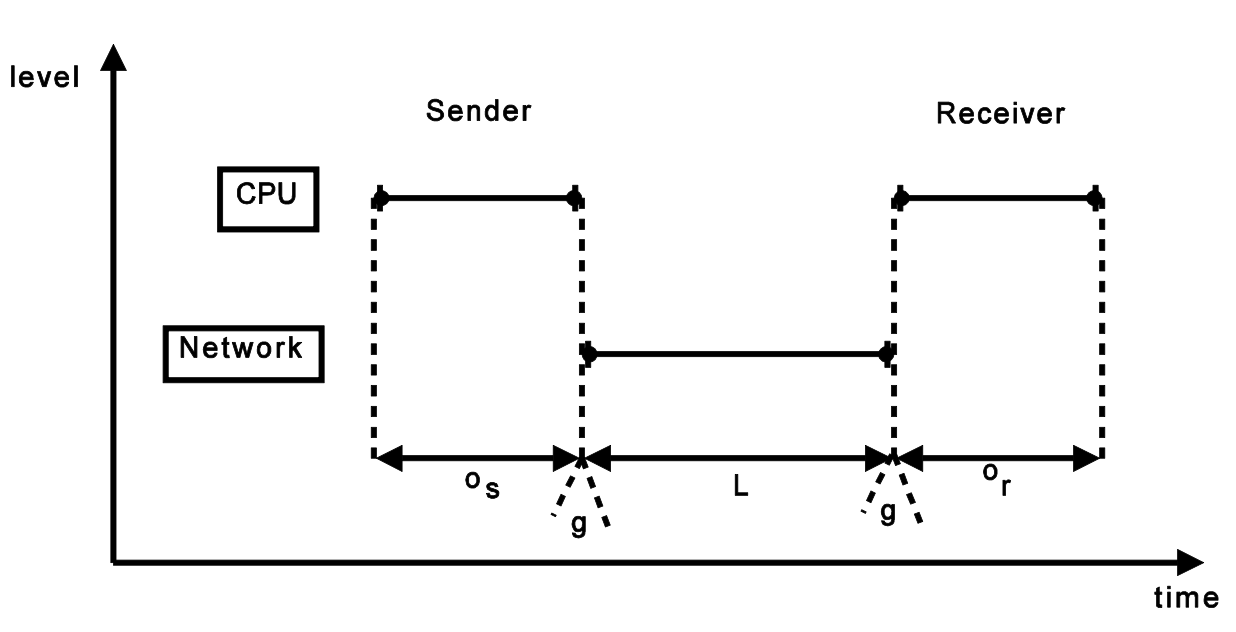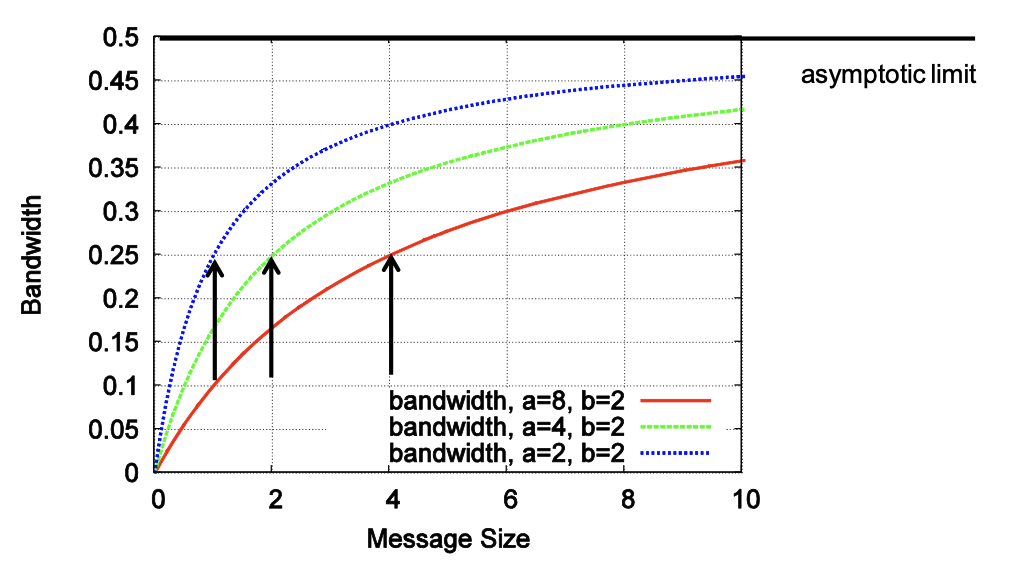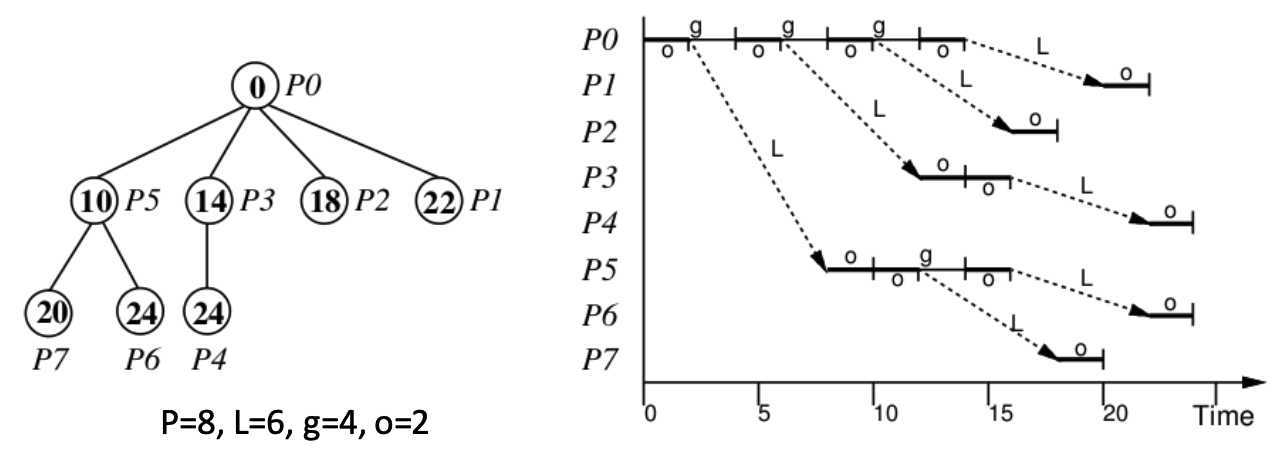Distributed Networking
Bandwidth vs. Latency
Transfer time
\[T(s) = \alpha + \beta s\]- $\alpha $ = startup time (latency)
- $\beta $ = cost per byte (bandwidth = $1/\beta $)
Effective bandwidth of a transfer:
- $E(s) = s / T(s)$
As $s$ increases, the effective bandwidth approaches $1/\beta $ asymptotically
- Convergence rate depends on α
- $s_{1/2} = \alpha /\beta $
Assuming no pipelining (new messages can only be issued from a process after all arrived)
- Two messages of size s between two processes cost $2(\alpha + s\beta )$
- Somewhat unrealistic (networks pipeline) but simple for now – we will lift this later!
$s_{1/2} = \alpha /\beta $ is often used to distinguish bandwidth- and latency-bound messages
Examples
Simplest linear broadcast
- One process has a data item to be distributed to all processes
Linearly broadcasting $s$ bytes among $P$ processes:
\[T (s) = (P − 1) ⋅ (\alpha + \beta s) = O(P)\]
k-ary Tree Broadcast
Origin process is the root of the tree, passes messages to $k$ neighbors which pass them on
- $k=2 \rightarrow$ binary tree
What is the broadcast time in the simple latency/bandwidth model?
- $T (s) ≈ \log_kP ⋅ k(\alpha + \beta s)$ (for fixed k)
What is the optimal $k$?
\[0 = \frac {k \ln P} {\ln k} \frac {d} {dk} = \frac {\ln P \ln k - \ln P} {\ln^2 k} \rightarrow k = e \approx 2.71\]Independent of $P, \alpha, \beta, s$?
Faster Trees?
Can we broadcast faster than in a ternary tree?
- Yes, because each non-leaf processor is idle after sending three messages!
- Those processors could keep sending!
- Result is a k-nomial tree
- For $k=2$, it’s a binomial tree
What about the runtime?
- $T (s) ≈ \log_kP ⋅ k(\alpha + \beta s)=O(\log P)$
What is the optimal $k$ here?
- $T(s) \frac d {dk}$ is monotonically increasing for $k>1$, thus $k_{opt}=2$
Can we broadcast faster than in a k-nomial tree?
- $O(\log P)$ is asymptotically optimal for $s=1$
- But what about large $s$?
Very Large Message Broadcast
Extreme case (P small, s large): simple pipeline
- Split message into $P$ segments
- Send segments from $PE_i$ to $PE_{i+1}$
- What is the runtime? $T(s) = (P − 1)(\alpha + \frac s P \beta)$
Compare $2$-nomial tree with simple pipeline for $α=10, β=1, P=4, s=10^6$
- $2,000,020$ vs. $1,000,030$
Can we do better for given $α, β, P, s$?
- Yes, mix those algorithms – quite complex!
What is a simple lower bound on the broadcast time?
\[T_{BC} \geq\min(\lceil\log_2(P)\rceil\alpha,s\beta)\]How close are the binomial tree for small messages and the pipeline for large messages (approximately)?
- Binary tree is a factor of $\log_2(P)$ slower in bandwidth
- Pipeline is a factor of $\frac P{\log_2(P)}$ slower in latency
What can we do for intermediate message sizes?
- Combine pipeline and tree → pipelined tree
What is the runtime of the pipelined binary tree algorithm?
\[T \approx (\frac s z \lceil \log_2 P\rceil-2)\cdot2\cdot(\alpha +z\beta)\]What is the optimal $z$?
\[z_{opt}=\sqrt{\frac {\alpha s} {\beta(\lceil \log_2P \rceil-2)}}\]Towards an Optimal Algorithm
What is the complexity of the pipelined tree with $z_{opt}$ for small $s$, large $P$ and for large $s$, constant $P$?
- Small messages, large $P$: $s=1; z=1$ $(s≤z)$, will give $O(\log P)$
- Large messages, constant $P$: assume $α, β, P$ constant, will give asymptotically $O(sβ)$
Asymptotically optimal for large P and s but bandwidth is off by a factor of 2! Why?
Intuition:
- In a binomial tree, all leaves ($P/2$) only receive data and never send
- results in wasted bandwidth
- Send along two simultaneous binary trees where the leaves of one tree are inner nodes of the other
- Construction needs to avoid endpoint congestion
The LogP Model
Defined by 4 parameters:
- L: an upper bound on the latency, or delay, incurred in communicating a message containing a word (or small number of words) from its source module to its target module.
- o: the overhead, defined as the length of time that a processor is engaged in the transmission or reception of each message; during this time, the processor cannot perform other operations.
- g: the gap, defined as the minimum time interval between consecutive message transmissions or consecutive message receptions at a processor. The reciprocal of g corresponds to the available per-processor communication bandwidth.
- P: the number of processor/memory modules.

We assume unit time for local operations and call it a cycle.
Examples
| Sending a single message | $T = 2o+L$ |
| Ping-Pong Round-Trip | $T_{RTT} = 4o+2L$ |
| Transmitting n messages | $T(n) = L+(n-1)\cdot\max(g, o) + 2o$ |
Simplifications
- $o > g$ on some machines
- $g$ can be ignored (eliminates max() terms)
- be careful with multi-core!
- Offloading networks might have very low $o$
- Can be ignored (not yet but hopefully soon)
- $L$ might be ignored for long message streams
- If they are pipelined
- Account $g$ also for the first message
- Eliminates $-1$
Benefits over Latency/Bandwidth Model
Models pipelining
- $\frac L g$ messages can be “in flight”
- Captures state of the art (cf. TCP windows)
Models computation/communication overlap
- Asynchronous algorithms
Models endpoint congestion/overload
- Benefits balanced algorithms
Example: Broadcasts
What is the LogP running time for a linear broadcast of a single packet?
\[T_{lin} = L + (P-2) * \max(o,g) + 2o\]Approximate the LogP runtime for a binary-tree broadcast of a single packet?
\[T_{bin} ≤ \log_2P * (L + \max(o,g) + 2o)\]Approximate the LogP runtime for an k-ary-tree broadcast of a single packet?
\[T_{k-n} ≤ \log_kP * (L + (k-1)\max(o,g) + 2o)\]Approximate the LogP runtime for a binomial tree broadcast of a single packet (assume $L> g$!)?
\[T_{bin} ≤ \log_2P * (L + 2o)\]Approximate the LogP runtime for a k-nomial tree broadcast of a single packet?
\[T_{k-n} ≤ \log_kP * (L + (k-2)\max(o,g) + 2o)\]What is the optimal $k$ (assume $o>g$)?
- Derive by $k$: $0 = o * \ln(k_{opt}) – L/k_{opt} + o$ (solve numerically)
- For larger $L$, $k$ grows and for larger $o$, $k$ shrinks
- Models pipelining capability better than simple model!
Can we do better than $k_{opt}$-ary binomial broadcast?
- Problem: fixed $k$ in all stages might not be optimal
- We can construct a schedule for the optimal broadcast in practical settings
Optimal Broadcast
Broadcast to $P-1$ processes
- each process who received the value sends it on;
- each process receives exactly once.
Optimal Broadcast Runtime
This determines the maximum number of PEs ($P(t)$) that can be reached in time $t$
- $P(t)$ can be computed with a generalized Fibonacci recurrence (assuming $o>g$):
- which can be bounded by

